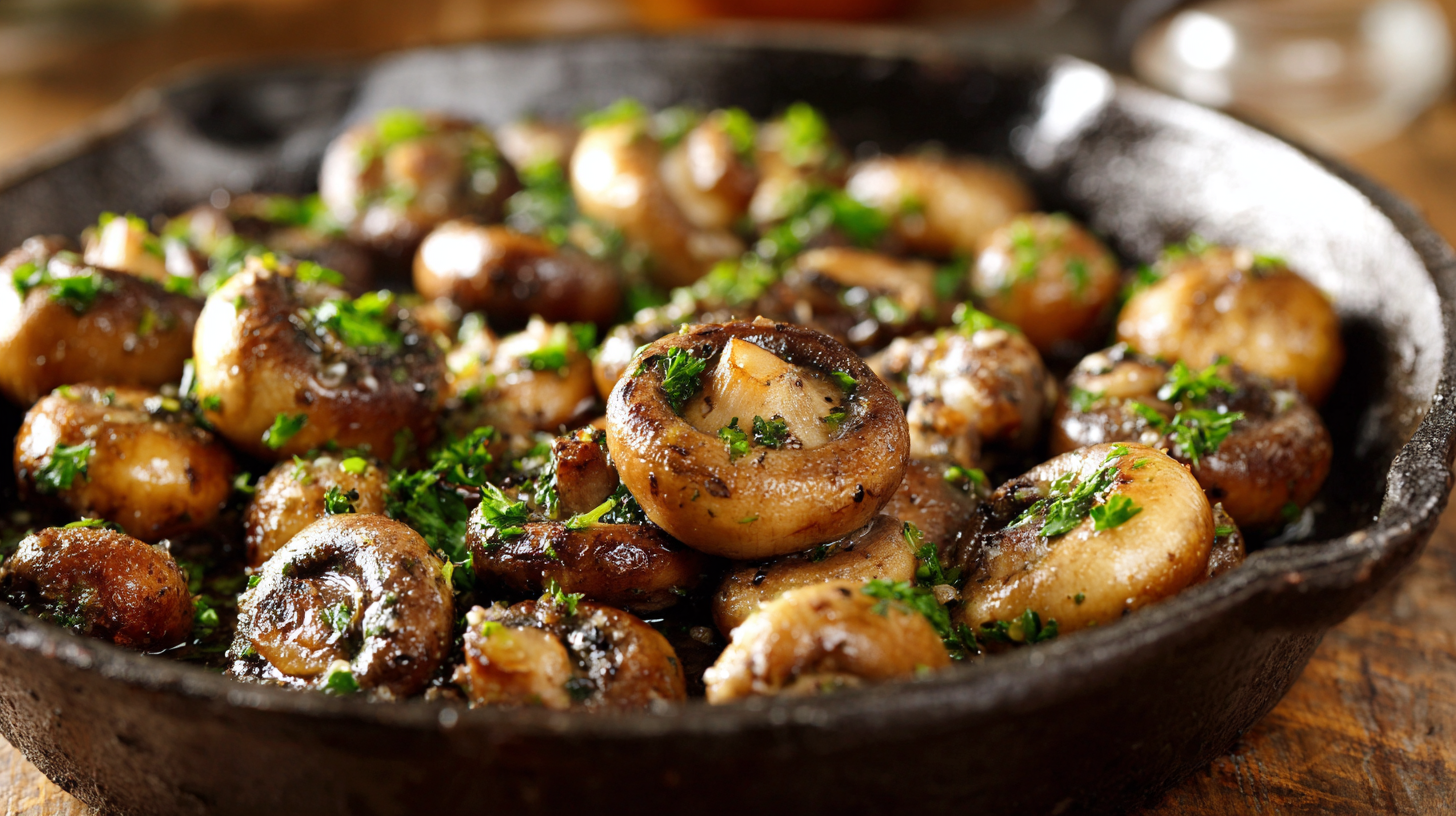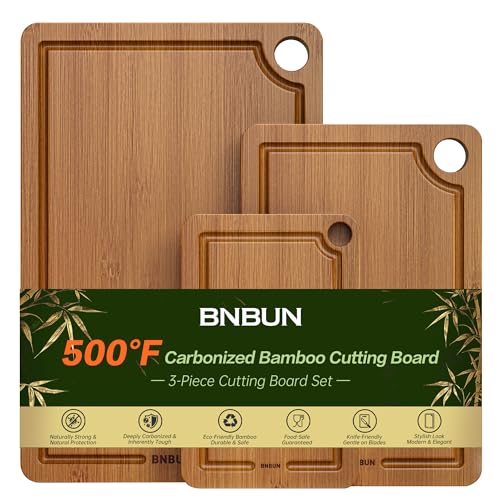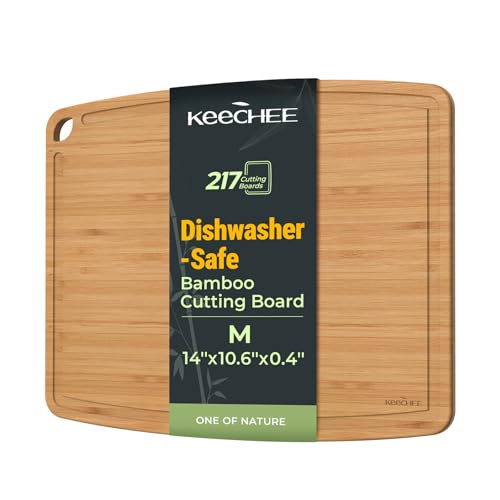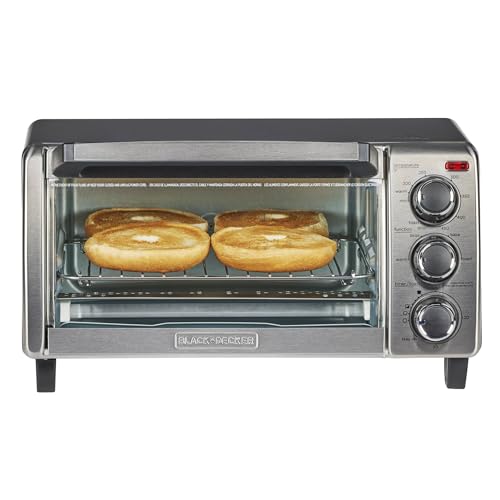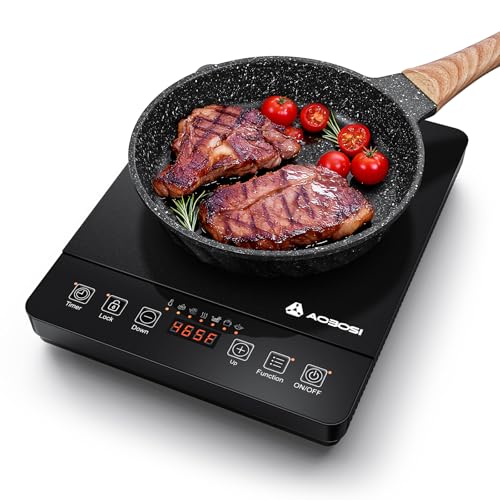The Perfect Sauteed Mushrooms Recipe
Transform ordinary mushrooms into an extraordinary side dish with this foolproof recipe. These sautéed mushrooms develop a beautiful golden-brown exterior while maintaining a juicy tender interior. Ready in just 15 minutes this recipe requires minimal ingredients but delivers maximum flavor.
Ingredients
- 1 pound mushrooms (cremini baby bella or white button)
- 3 tablespoons butter
- 2 tablespoons olive oil
- 3-4 cloves garlic minced
- 1 tablespoon fresh thyme leaves (or 1 teaspoon dried)
- 2 tablespoons dry white wine or broth (optional)
- 1 tablespoon soy sauce
- Salt and freshly ground black pepper to taste
- 2 tablespoons fresh parsley chopped
- Pinch of red pepper flakes (optional)
Step-by-Step Instructions
- Prepare the mushrooms: Clean mushrooms by wiping them with a damp paper towel or brushing off any dirt. Avoid washing them under running water as they absorb moisture quickly. Slice larger mushrooms and leave smaller ones whole or halved.
- Heat the pan: Place a large skillet over medium-high heat. Add butter and olive oil. The combination prevents the butter from burning while adding rich flavor.
- Add mushrooms: Once the butter is melted and bubbling add the mushrooms to the pan in a single layer. Resist the urge to stir immediately – allowing them to sit undisturbed for 2-3 minutes creates proper caramelization.
- Season and sauté: Sprinkle mushrooms with a pinch of salt and continue cooking for 5-7 minutes stirring occasionally until they release their moisture and begin to turn golden brown.
- Add aromatics: Reduce heat to medium and add minced garlic thyme and red pepper flakes (if using). Sauté for 30-60 seconds until fragrant.
- Deglaze the pan: Pour in the white wine or broth and soy sauce scraping up any browned bits from the bottom of the pan. These bits contain concentrated flavor that enriches your dish.
- Finish cooking: Cook for another 1-2 minutes until the liquid has mostly evaporated and mushrooms are deeply browned and tender.
- Final touches: Remove from heat and stir in fresh parsley. Taste and adjust seasoning with additional salt and pepper if needed.
Tips for Perfect Sautéed Mushrooms
- Don’t overcrowd the pan: Cook mushrooms in batches if necessary. Overcrowding causes them to steam rather than sauté resulting in soggy mushrooms.
- High heat is essential: A properly hot pan ensures mushrooms sear rather than steam creating that desirable caramelized exterior.
- Patience pays off: Allow mushrooms to cook undisturbed initially to develop proper browning before stirring.
- Mushroom varieties: While this recipe works with any mushroom variety mixing different types creates interesting textures and flavors.
- Storage: Leftover sautéed mushrooms keep well in an airtight container in the refrigerator for up to 3 days. Reheat gently in a skillet or microwave.
Why You’ll Love These Sauteed Mushrooms
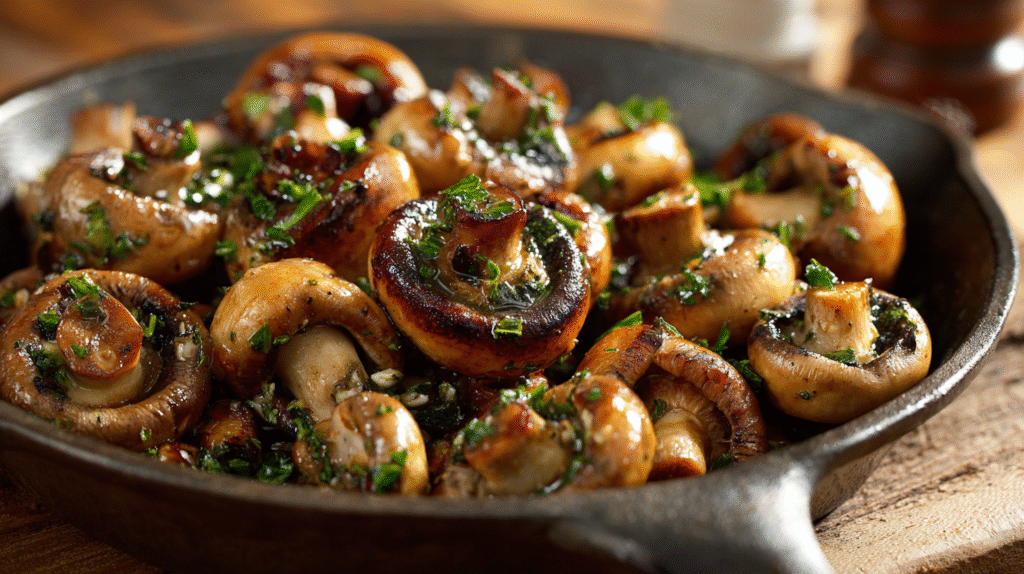
These sauteed mushrooms will quickly become a staple in your kitchen rotation for good reason. Their versatility allows them to complement almost any main dish from steaks to pasta or even as a topping for crostini.
The deeply savory umami flavor profile these mushrooms develop is unmatched by any other cooking method. With just a few simple ingredients you’ll transform ordinary mushrooms into something extraordinary.
Time is precious and these sauteed mushrooms respect that by coming together in under 15 minutes while tasting like they took much longer. Your guests will never guess how simple they were to prepare.
Nutritionally speaking these mushrooms pack impressive benefits including essential vitamins minerals and antioxidants while remaining low in calories. They provide satisfying texture and flavor without weighing down your meal.
Restaurant-quality results are achievable right in your home kitchen with this foolproof technique. The combination of butter olive oil and aromatics creates a luxurious sauce that coats each mushroom perfectly.
Meal prep becomes easier since these mushrooms store beautifully for several days making them perfect for planning ahead. They actually improve in flavor as they sit giving you delicious ready-to-use mushrooms whenever inspiration strikes.
Ingredients You’ll Need
To create these perfectly sautéed mushrooms that will transform your meals, gather these simple yet essential ingredients:
- 1 pound (450g) fresh mushrooms (cremini, button, shiitake, or a mix)
- 3 tablespoons butter
- 2 tablespoons olive oil
- 4 cloves garlic, minced
- 1 tablespoon fresh thyme leaves (or 1 teaspoon dried)
- 2 tablespoons white wine or vegetable broth (optional)
- Salt and freshly ground black pepper to taste
- 1 tablespoon chopped fresh parsley for garnish (optional)
The star ingredient is obviously the mushrooms themselves. Choose firm, fresh specimens without slimy spots or excessive moisture. Cremini mushrooms offer a more robust flavor than white button mushrooms, while shiitake brings an earthier note to the dish. Feel free to use a single variety or create a mushroom medley for more complex flavors.
Butter and olive oil work together perfectly in this recipe – butter provides rich flavor while olive oil prevents burning at higher temperatures. Fresh garlic and thyme infuse the mushrooms with aromatic depth that dried alternatives simply cannot match. The optional splash of white wine or broth helps deglaze the pan, capturing all those flavorful browned bits that develop during cooking.
Salt and pepper are crucial for improving the natural umami flavor of mushrooms. Add them toward the end of cooking to prevent drawing out excess moisture too early in the process. Fresh parsley adds a bright, colorful finish that complements the earthy tones of your perfectly sautéed mushrooms.
Tools and Equipment
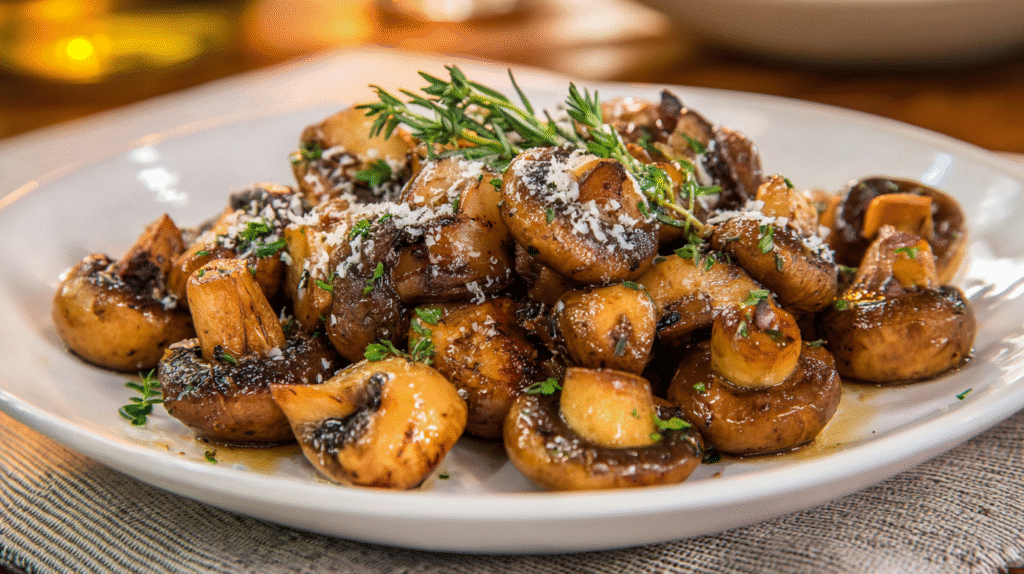
Creating perfect sautéed mushrooms doesn’t require fancy kitchen gadgets, but having the right tools makes all the difference in achieving that golden-brown exterior and juicy interior. Here’s what you’ll need to prepare this delicious side dish:
- Large skillet or frying pan – A 10-12 inch skillet provides enough surface area to sauté mushrooms without overcrowding. Cast iron works exceptionally well for developing deep flavor and even browning.
- Wooden spoon or heat-resistant spatula – Essential for stirring and flipping the mushrooms without damaging your pan’s surface.
- Sharp knife – Makes quick work of trimming and slicing mushrooms to your preferred thickness.
- Cutting board – Provides a stable surface for prepping your mushrooms and mincing garlic.
- Measuring spoons – Ensures accuracy when adding butter, oil, and seasonings.
- Small bowl – Useful for holding prepared garlic and herbs before adding them to the pan.
- Paper towels – Helpful for gently cleaning mushrooms before cooking (avoid soaking them in water).
The most critical piece of equipment is your skillet. Heavy-bottomed pans retain heat better and create more even cooking temperatures, resulting in that perfect golden sear. Stainless steel and cast iron skillets offer superior heat retention and develop excellent fond (those flavorful browned bits on the pan bottom) that will enrich your finished dish.
Your wooden spoon or spatula should be sturdy enough to toss and turn the mushrooms without breaking. Silicone tools work well too, as they withstand high heat without melting or scratching your cookware.
Choosing the Right Mushrooms
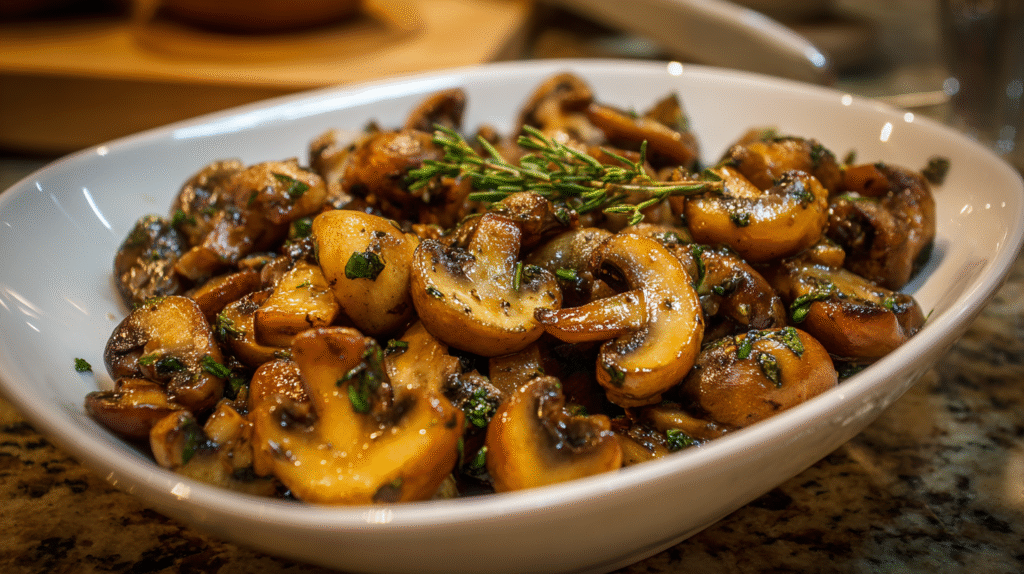
The foundation of exceptional sautéed mushrooms begins with selecting the perfect fungi for your pan. Your choice of mushroom varieties dramatically impacts both flavor and texture in the final dish.
Best Mushroom Varieties for Sauteing
Cremini Mushrooms (Baby Bellas) offer a meatier texture and richer flavor than their white button cousins. These brown mushrooms hold up beautifully when sautéed and develop a deep umami character.
Button Mushrooms provide a mild flavor that absorbs other ingredients well. Their firm texture stands up to high-heat cooking while maintaining a pleasant bite.
Shiitake Mushrooms deliver an intensely earthy flavor profile with a satisfying chewy texture. Remove the tough stems before cooking as they can remain woody even after sautéing.
Portobello Mushrooms work wonderfully when sliced and sautéed. Their substantial texture and robust flavor make them almost meat-like when properly browned.
Oyster Mushrooms offer delicate, velvety texture with subtle seafood notes. They cook quickly and absorb flavors beautifully.
Wild Mushroom Blends combine varieties like chanterelles, morels, or porcini for complex flavor profiles. These specialty mushrooms often command higher prices but reward with extraordinary depth of flavor.
For best results, select mushrooms that feel firm and dry to the touch. Avoid specimens with dark spots, sliminess, or wrinkled caps. Fresh mushrooms should smell earthy and clean rather than sour or ammonia-like.
Cleaning and Preparing Mushrooms
Properly preparing mushrooms prevents sogginess and ensures optimal browning. Contrary to popular belief, mushrooms don’t need to be soaked or extensively washed.
Gently wipe each mushroom with a damp paper towel or soft brush to remove dirt. For particularly dirty mushrooms, you can quickly rinse under cold running water but never soak them. Mushrooms act like sponges and absorb water rapidly, which inhibits proper browning.
Trim any dried or discolored stem ends before cooking. For varieties like shiitake or portobello, remove the entire stem as they tend to remain tough after cooking.
Slice mushrooms uniformly to ensure even cooking. Thicker slices (about ¼-inch) maintain a satisfying texture while thinner slices cook more quickly and absorb more flavors. Quarter very small mushrooms and halve medium-sized ones for consistent cooking.
Allow cleaned mushrooms to dry completely before adding them to your hot pan. Excess moisture creates steam, preventing the caramelization that develops those desirable rich flavors.
Store unwashed mushrooms in a paper bag in your refrigerator until ready to use. This allows air circulation while absorbing excess moisture, extending their shelf life significantly compared to plastic storage.
How to Saute Mushrooms Perfectly
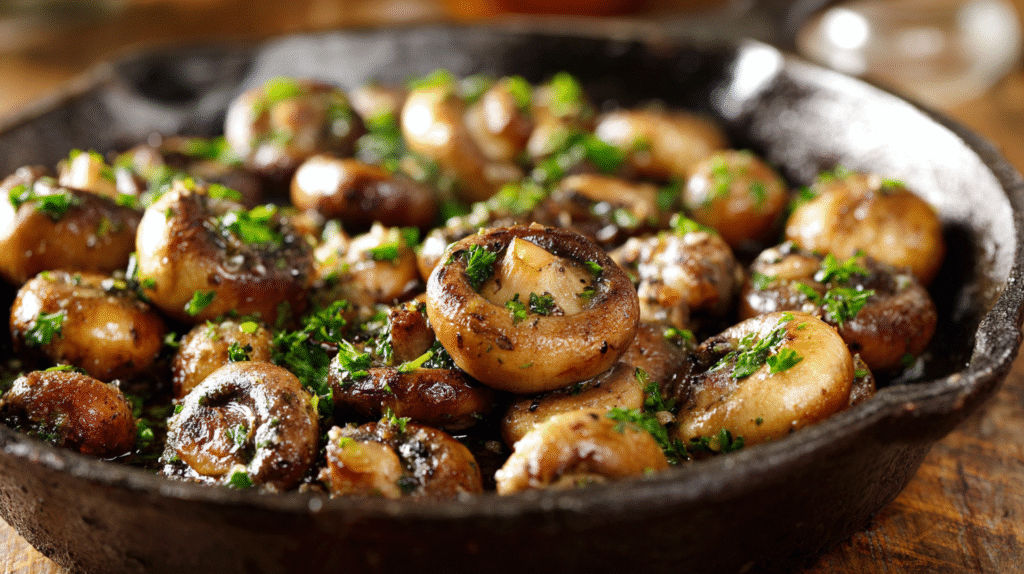
Sautéing mushrooms properly transforms them from bland fungi into flavor-packed culinary gems. The technique is straightforward but requires attention to a few key details that make all the difference.
Step 1: Preparing Your Pan
Select a large skillet or frying pan that allows ample space for your mushrooms to cook without crowding. Heat the pan over medium-high heat until it’s thoroughly hot before adding any fat. Add your butter and olive oil combination to the hot pan and wait until the butter melts completely and begins to foam slightly. This temperature ensures your mushrooms will sear rather than steam. The pan should be hot enough that a drop of water sizzles immediately upon contact but not so hot that the butter burns. Your cooking surface needs to reach the proper temperature before mushrooms are introduced to achieve that coveted golden-brown exterior.
Step 2: Cooking the Mushrooms
Add your sliced mushrooms to the hot pan in a single layer without overcrowding. Resist the urge to stir immediately – allow mushrooms to cook undisturbed for 2-3 minutes until they develop a golden brown sear on one side. Flip or stir them once this initial browning occurs. Mushrooms will first release moisture then begin to reabsorb flavorful fats as they continue cooking. Cook for another 3-4 minutes until most moisture has evaporated and mushrooms have shrunk considerably while turning deep golden brown. You’ll notice them becoming more tender while maintaining a pleasant bite. Their color should deepen significantly during this process as they concentrate in flavor.
Step 3: Adding Aromatics and Seasonings
Lower heat to medium once mushrooms have browned properly. Add minced garlic and fresh thyme leaves to the pan stirring frequently for about 30 seconds until fragrant but not burned. Garlic burns quickly so monitor it carefully during this brief cooking period. Pour in white wine or broth if using allowing it to sizzle vigorously while you scrape up any browned bits from the bottom of the pan. This deglazing process incorporates concentrated flavor back into your dish. Let the liquid reduce by half which typically takes 1-2 minutes depending on pan size and heat level.
Step 4: Finishing Touches
Season your mushrooms with salt and freshly ground black pepper tasting and adjusting as needed. Remember mushrooms absorb salt readily so start with less than you might think necessary. Add a final small pat of butter if desired swirling it into the mushrooms until glossy and richly coated. This mounting butter technique creates a silky texture and adds depth to the final dish. Sprinkle with chopped fresh parsley just before serving for a bright color contrast and fresh flavor note. Transfer to a warm serving dish immediately to prevent overcooking. The finished mushrooms should glisten with absorbed fats maintain their shape yet yield easily when bitten and deliver an intensely savory experience that complements countless dishes.
Tips for Crispy, Not Soggy Mushrooms
Achieving perfectly crispy sautéed mushrooms requires understanding a few crucial techniques that prevent them from becoming waterlogged. Mushrooms naturally contain high water content which can lead to steaming instead of sautéing if not handled properly. Follow these expert tips to ensure your mushrooms develop that coveted golden exterior and meaty texture every time.
Use High Heat
Start with a properly preheated pan before adding any fat or mushrooms. Your skillet should be hot enough that a drop of water sizzles immediately upon contact. High heat helps quickly evaporate the moisture released from mushrooms, allowing them to brown rather than steam. Maintain this temperature throughout the cooking process for optimal results.
Don’t Overcrowd the Pan
Placing too many mushrooms in your pan creates a crowded environment where they steam rather than sauté. Work in batches if necessary, giving each mushroom slice adequate space. A single layer with small gaps between pieces allows moisture to escape efficiently and promotes even browning. Remember that mushrooms will shrink considerably during cooking, but starting with proper spacing remains essential.
Salt at the Right Time
Add salt toward the end of the cooking process rather than at the beginning. Salt draws out moisture from mushrooms, which can prevent proper browning if added too early. Wait until the mushrooms have developed a golden color before seasoning with salt to preserve their crispy texture. This simple timing adjustment makes a remarkable difference in the final result.
Keep the Mushrooms Dry
Avoid washing mushrooms under running water whenever possible. Instead, clean them by gently wiping with a damp paper towel or using a mushroom brush to remove any dirt. If washing is absolutely necessary, do so quickly and thoroughly pat them dry with paper towels before cooking. Excess moisture is the enemy of crispy mushrooms.
Let Them Cook Undisturbed
Resist the urge to constantly stir the mushrooms during the initial cooking phase. Allow them to sit undisturbed for 3-4 minutes after adding them to the hot pan. This patience creates direct contact with the hot surface, encouraging proper browning. Once the first side has developed a golden crust, then you can stir to cook the remaining sides.
Use the Right Fat Combination
Combining butter with olive oil provides the perfect medium for crispy mushrooms. The olive oil prevents the butter from burning at high heat, while the butter imparts rich flavor. This combination creates the ideal environment for achieving that golden exterior without sacrificing taste or risking burnt bits.
Flavor Variations
The beauty of sautéed mushrooms lies in their versatility and ability to take on different flavor profiles. These variations will transform your basic recipe into something extraordinary that suits any meal or preference.
Garlic Butter Mushrooms
Intensify the savory experience by creating garlic butter mushrooms that deliver bold flavor in every bite. Start with the basic sautéed mushrooms recipe but double the garlic amount to 4-6 cloves minced or thinly sliced. Add the garlic earlier in the cooking process about halfway through sautéing the mushrooms rather than near the end. Increase the butter to 3 tablespoons while reducing olive oil to 1 tablespoon for a richer buttery foundation. For an extra dimension of flavor incorporate 1 teaspoon of garlic powder along with the fresh garlic. Finish with a sprinkle of freshly grated Parmesan cheese just before serving to create a nutty complement to the intense garlic notes.
Herb-Infused Mushrooms
Elevate your sautéed mushrooms with fresh herbs that add complexity and aromatic appeal. Replace standard thyme with a robust herb blend using 1 tablespoon each of fresh chopped rosemary thyme and sage. Mediterranean-style mushrooms can be created by adding 1 teaspoon dried oregano 1 tablespoon fresh basil and a pinch of red pepper flakes. For an Asian-inspired variation substitute the herbs with 1 tablespoon of fresh ginger 1 tablespoon chopped scallions and 1 teaspoon of toasted sesame oil added at the end of cooking. Woodland mushrooms benefit from more earthy herbs like 2 tablespoons chopped tarragon or 1 tablespoon fresh marjoram which enhance their natural forest flavors. Always add delicate herbs like parsley cilantro or chives after removing the pan from heat to preserve their bright flavors and colors.
Wine-Glazed Mushrooms
Transform ordinary mushrooms into restaurant-quality side dishes with various wine glazes that create depth and complexity. For red wine mushrooms replace the white wine with ¼ cup of dry red wine like Cabernet Sauvignon or Merlot which creates a richer deeper flavor profile perfect for serving alongside steak. Create marsala mushrooms by using ⅓ cup of marsala wine with 1 teaspoon of brown sugar for a slightly sweet Italian-inspired variation that pairs beautifully with chicken dishes. For an elegant French approach use ¼ cup of dry sherry with a teaspoon of Dijon mustard whisked in after deglazing the pan. White wine mushrooms benefit from aromatics like shallots adding 2 tablespoons of minced shallots before the garlic. The key to perfect wine-glazed mushrooms is allowing the alcohol to fully reduce until the mushrooms are glossy and coated with concentrated flavor about 2-3 minutes of simmering after adding the wine.
Serving Suggestions
These versatile sautéed mushrooms shine as both a supporting player and star attraction on your table. Serve them alongside a perfectly seared steak for a classic pairing that enhances the meat’s rich flavors. Spoon these golden beauties over creamy polenta or risotto to create an elegant vegetarian main course that satisfies with deep umami notes.
Transform ordinary pasta into a gourmet experience by tossing hot fettuccine or pappardelle with these mushrooms and a splash of cream. For breakfast enthusiasts nothing beats these savory mushrooms atop avocado toast or tucked into a fluffy omelet with sharp cheddar cheese.
Create an impressive appetizer by piling the sautéed mushrooms onto crostini with a smear of goat cheese and fresh herbs. They also make an excellent topping for homemade pizza alongside caramelized onions and fontina cheese.
For a complete meal incorporate these mushrooms into grain bowls with quinoa barley or farro adding roasted vegetables and a tangy vinaigrette. During holiday gatherings serve them as part of a spectacular charcuterie board where their earthy flavor complements cured meats and aged cheeses.
These mushrooms elevate simple baked potatoes when spooned over the top with a dollop of sour cream and chives. For an impressive yet easy entertaining option fill phyllo cups with the sautéed mushrooms and top with a small piece of brie before warming briefly in the oven.
The versatility of these sautéed mushrooms extends to international cuisines too add them to tacos with crema and cilantro for a vegetarian option or incorporate them into Asian inspired lettuce wraps with water chestnuts and hoisin sauce.
Storage and Reheating
Properly stored sautéed mushrooms retain their flavor and texture for several days. Store your cooled mushrooms in an airtight container in the refrigerator for up to 4 days. Their flavor actually improves overnight as the mushrooms continue to absorb the seasonings and aromatics.
For longer preservation, freeze your sautéed mushrooms in a freezer-safe container for up to 3 months. Layer parchment paper between portions if stacking to prevent them from freezing together. Freezing works surprisingly well with mushrooms, though they may release additional moisture when thawed.
When reheating refrigerated mushrooms, use a skillet over medium heat for 3-5 minutes until warmed through. This method helps maintain their texture and prevents sogginess. Add a small amount of butter or olive oil to refresh their flavor and prevent sticking.
Frozen mushrooms should be thawed in the refrigerator overnight before reheating. Once thawed, drain any excess liquid and reheat in a skillet as described above. Pat them with paper towels if they seem watery.
Microwaving works in a pinch—place mushrooms in a microwave-safe dish and heat in 30-second intervals, stirring between each interval. The texture won’t be quite as good as with stovetop reheating, but the flavor remains intact.
Leftover sautéed mushrooms are versatile ingredients for quick meals. Add them cold to salads, fold them into room-temperature pasta dishes, or stir them into scrambled eggs for an instant flavor boost without additional cooking.
Nutritional Benefits of Mushrooms
Mushrooms deliver impressive nutritional value while remaining exceptionally low in calories. These versatile fungi pack a powerful nutrient punch with just 15-20 calories per cup making them perfect for anyone watching their weight without sacrificing flavor.
Protein content in mushrooms stands out among vegetables with about 3 grams per serving. They provide essential amino acids your body needs while containing virtually no fat and zero cholesterol. Their fiber content promotes digestive health and helps maintain fullness between meals.
Mushrooms contain an abundance of vitamins and minerals crucial for optimal health:
- Vitamin D: One of the few non-animal food sources naturally containing vitamin D when exposed to sunlight
- B vitamins: Rich in riboflavin (B2) niacin (B3) and pantothenic acid (B5) which support energy metabolism
- Selenium: A powerful antioxidant that helps protect cells from damage
- Copper: Essential for red blood cell formation and nerve health
- Potassium: Crucial for heart muscle function and blood pressure regulation
The antioxidant content in mushrooms deserves special attention. They contain ergothioneine and glutathione two compounds that help fight oxidative stress and inflammation in your body. Research suggests these antioxidants may help reduce risks of age-related diseases and support overall immune function.
Mushrooms also contain beta-glucans unique polysaccharides that stimulate immune system activity. These compounds have been studied for their potential anti-cancer properties and ability to modulate immune response. Regular consumption of mushrooms may contribute to your body’s natural defense mechanisms.
Different mushroom varieties offer slightly different nutritional profiles. Cremini and portobello mushrooms provide more potassium than white button varieties while shiitake mushrooms contain higher amounts of copper and vitamin D. Oyster mushrooms excel in iron content making them valuable for those needing to boost their iron intake.
Adding sautéed mushrooms to your meals introduces these nutritional benefits in a delicious package. The cooking process preserves most nutrients while improving flavor. When prepared with minimal added fat as in our sautéed mushroom recipe you maximize nutritional value while creating a versatile side dish that complements countless meals.
Conclusion
Mastering sautéed mushrooms is a game-changer for your culinary repertoire. With just a hot pan good butter and a few aromatics you’ll transform ordinary mushrooms into extraordinary bites bursting with umami goodness in under 15 minutes.
These versatile mushrooms will elevate everything from steaks to pasta while providing impressive nutritional benefits. Whether you stick with the classic recipe or explore flavor variations with herbs and wine you’re creating a dish that improves with time.
Remember the key techniques: high heat no overcrowding and patience during cooking. Your reward? Restaurant-quality mushrooms that can be enjoyed immediately or stored for quick meal additions throughout the week. Now that you know the secrets nothing stands between you and perfectly sautéed mushrooms every time.

